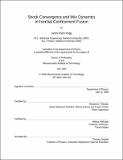| dc.contributor.advisor | Richard D. Petrasso. | en_US |
| dc.contributor.author | Rygg, James Ryan | en_US |
| dc.contributor.other | Massachusetts Institute of Technology. Dept. of Physics. | en_US |
| dc.date.accessioned | 2007-11-15T21:34:47Z | |
| dc.date.available | 2007-11-15T21:34:47Z | |
| dc.date.copyright | 2006 | en_US |
| dc.date.issued | 2006 | en_US |
| dc.identifier.uri | http://hdl.handle.net/1721.1/39483 | |
| dc.description | Thesis (Ph. D.)--Massachusetts Institute of Technology, Dept. of Physics, 2006. | en_US |
| dc.description | This electronic version was submitted by the student author. The certified thesis is available in the Institute Archives and Special Collections. | en_US |
| dc.description | Includes bibliographical references (p. 123-124). | en_US |
| dc.description.abstract | Understanding the phenomena of shock propagation and of turbulent mix induced by Rayleigh-Taylor (RT) instability growth is of critical importance for ignition and high gain in inertial confinement fusion (ICF). Capsule assembly and hot-spot formation require careful timing of multiple shocks to maximize hot-spot heating while minimizing heating of the main fuel. Unmitigated mixing of the main fuel with the hot-spot can quench hot-spot heating, resulting in reduced gain or failed ignition. Nuclear measurements of direct-drive implosions at the OMEGA laser facility were performed to study shock convergence and mix dynamics in ICF. During these studies, an unexpected scaling of experimental nuclear yields was observed in implosions of capsules filled with different mixtures of D2 and 3He. A number of possible mechanisms to cause the scaling were considered, but no dominant mechanism has been identified. Mix dynamics were studied using a novel capsule configuration that only emits D3He protons when the fuel and shell are atomically mixed. Temporal and spectral measurements of protons emitted from such capsules were used to investigate the extent and evolution of mix, and demonstrate that the time necessary for RT instabilities to induce mix results in a delay of the peak D3He reaction rate in these special capsules compared to standard capsules. | en_US |
| dc.description.abstract | (cont.) The collapse of a converging spherical shock launched by the onset of the laser pulse induces nuclear production several hundred picoseconds before deceleration and stagnation of the imploding shell. The time, duration, nuclear yields, temperature, and target compression of this shock-induced burn were measured and compared to 1-D simulations. The simulations significantly overestimate the yields, time, and compression, even though the shock collapse and resulting nuclear reaction history were experimentally demonstrated to be 1-D in nature. A 1-D model of shock convergence was constructed to gain insight into the discrepancy between experiments and simulations by extending Guderley's converging shock analysis. It is hoped that the constraints imposed by these nuclear measurements of shock convergence and mix dynamics will enable useful tests to affirm the validity or improve the utility of the analytic and numerical tools used to understand these phenomena. | en_US |
| dc.description.statementofresponsibility | by James Ryan Rygg. | en_US |
| dc.format.extent | 124 p. | en_US |
| dc.language.iso | eng | en_US |
| dc.publisher | Massachusetts Institute of Technology | en_US |
| dc.rights | M.I.T. theses are protected by copyright. They may be viewed from this source for any purpose, but reproduction or distribution in any format is prohibited without written permission. See provided URL for inquiries about permission. | en_US |
| dc.rights.uri | http://dspace.mit.edu/handle/1721.1/7582 | |
| dc.subject | Physics. | en_US |
| dc.title | Shock convergence and mix dynamics in inertial confinement fusion | en_US |
| dc.type | Thesis | en_US |
| dc.description.degree | Ph.D. | en_US |
| dc.contributor.department | Massachusetts Institute of Technology. Department of Physics | |
| dc.identifier.oclc | 174146354 | en_US |
